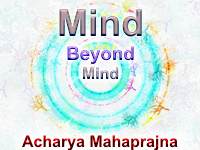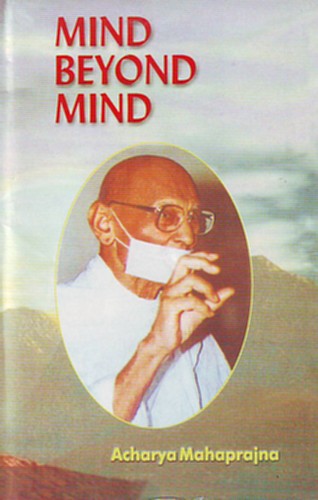
We had referred to three elements of Preksha Dhyna in the previous chapter. They are breath, sound and body. Respiration is an organic process. Sound is produced artificially and has to be apprehended imaginatively. The human body is a natural entity. In this chapter we will discuss sound as an implement of meditation.
Ordinarily we try to understand the world in the light of our preconceived notions and predilections with the result that we are not able to see things as they are. I shall narrate a story to illustrate this fact.
A certain gentleman used to go out for a walk along the bank of a river. A fish, which lived in the river, saw the reflection of the man in the water of the river. It saw the image for a number of days and thought that the man whose image it saw stood and walked on his head, for in the reflected image the head remained downwards and the feet upwards. One day the fish came on the surface of the water and saw the man standing on the bank of the river. It began to wonder how the man stood on his feet now. Probably he was doing some exercise by standing on his feet. We are like the fish. We do not see things as they are but only as they appear to us. In other words, we entertain illusions about reality. All appearances are illusions. We entertain thousands of such illusions. The exercise of Anupreksha in the process of Preksha Dhyana is aimed at destroying such illusions.
There are two terms: Preksha and Anupreksha. The latter implies an attempt to see truth, to see things as they are and not as they appear to us. In other words, it means eliminating our predilections and prepossessions, which distort our vision of reality. The vision of reality is the result of an objective perception. It means an unbiased vision of things. The aim of Preksha meditation is to arrive at such a vision. There cannot be any preconditions attached to such a vision. Anupreksha means complete absorption in truth. It is the admission of reality as such.
The whole world we live in is a conglomeration of vibrations. These vibrations are happening with a terrific-speed. There is a danger of our being lost in a typhoon of vibrations. The only saving grace is that the human body is not sensitive enough to catch these vibrations. If it were, it will be hammered into pieces in no time and destroyed. There are millions and billions of sounds, most of them terrible. We can catch only a few of them. When we think, our minds produce innumerable vibrations. Every action we do produces disturbances in the atmosphere. Millions of men who lived and did things in the past have left behind them countless vibrations in the gravitational field of the earth. These vibrations are still active. Innumerable networks of these vibrations produced in the past are spread around us. Scientists are busy investigating them.
Thought currents produced by the minds of millions of men in the past as well as the present are active in the universe and scientists are trying to invent devices through they could be recorded. If we succeed in recording the vibrations produced by the voices of Mahavira or Buddha or any other great man in their original form, we would get an opportunity to check the interpolations put in them by the succeeding generations. Thus we will be able to know what they actually spoke and what they are supposed to have spoken. The entire universe we live in is still being stuffed with such vibrations.
The Visisavsyaka Bhasya which, is a Jain canon, says that when we breathe, the vibrations produced in the air disturb and cause pain to the water beings if we sit near a pond and breathe. When we tear a piece of cloth, innumerable subtle particles shoot forth from the cloth into the air, disturb, and cause pain to the air beings. It has, therefore, been prescribed for the practitioner of Animesa Dhyana that he should not meditate on living plants, because the magnetic currents issuing forth from his eyes cause injury to the plant meditated upon. The Jain monk is instructed not to sit on the bare ground, because the heat produced by his body is likely to cause injury to the earth beings. This shows how penetrating the super sensory vision of the Jain Acaryas was. We can appreciate this in the light of the knowledge and discoveries of science and technology. We were totally ignorant of this truth earlier. All kinds of vibrations produced in the past as well as present are being accumulated in the earth's atmosphere. The Acaryas perceived this, which is beyond our comprehension. They stood on a higher plane and commanded a wider and far more comprehensive view of the world around them. We, on the other hand, stand on a lower plane of experience. They had dived deeper into consciousness, and therefore, commanded super sensory sight. Anyhow, it is not fair to deride those who stand on a lower plane. Their judgments are correct with reference to the lower plane. They cannot judge otherwise. If you keep the window of your room open and stand at it, you will be able to have a panorama of hills standing at a long distance, which you will not have when you keep your head below the base of the window.
What I have said above explains the different judgments regarding the gross world and those concerning the subtle world. The difference can be rationally explained. The practitioner should first understand this difference before he begins Anupreksha. He has to develop the correct mood and disposition by exerting himself. He should not allow his predispositions and predilections to give him a false vision of truth. A predisposed mind is a great hindrance in sadhana. The practitioner has to overcome this otherwise he will be misled. He will have to adopt new attitudes, which is not an easy task. There are myriads of vicious circles entrapping our minds. It is not enough simply to break them. We must create new tendencies and attitudes capable of giving us a correct vision of reality in place of the old ones, which distort it. You cannot get rid of covetousness without developing the attitude of selflessness. You cannot successfully give up anger without developing a spiritual equilibrium in you.
 Acharya Mahaprajna
Acharya Mahaprajna

